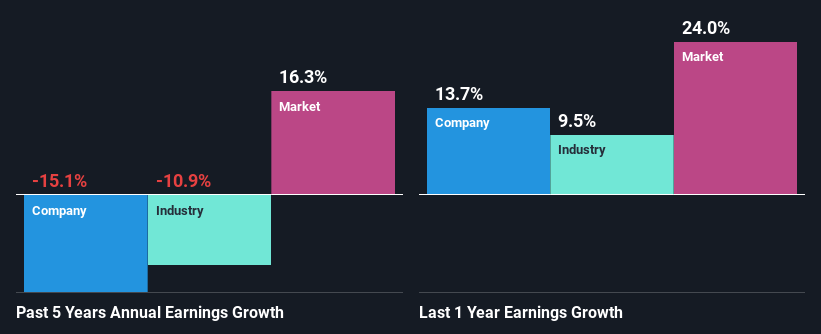It is hard to get excited after looking at Magna International’s (TSE:MG) recent performance, when its stock has declined 13% over the past month. However, the company’s fundamentals look pretty decent, and long-term financials are usually aligned with future market price movements. In this article, we decided to focus on Magna International’s ROE.
ROE or return on equity is a useful tool to assess how effectively a company can generate returns on the investment it received from its shareholders. In short, ROE shows the profit each dollar generates with respect to its shareholder investments.
View our latest analysis for Magna International
How Do You Calculate Return On Equity?
The formula for return on equity is:
Return on Equity = Net Profit (from continuing operations) ÷ Shareholders’ Equity
So, based on the above formula, the ROE for Magna International is:
11% = US$1.3b ÷ US$12b (Based on the trailing twelve months to March 2022).
The ‘return’ refers to a company’s earnings over the last year. One way to conceptualize this is that for each CA$1 of shareholders’ capital it has, the company made CA$0.11 in profit.
Why Is ROE Important For Earnings Growth?
Thus far, we have learned that ROE measures how efficiently a company is generating its profits. We now need to evaluate how much profit the company reinvests or “retains” for future growth which then gives us an idea about the growth potential of the company. Assuming everything else remains unchanged, the higher the ROE and profit retention, the higher the growth rate of a company compared to companies that don’t necessarily bear these characteristics.
Magna International’s Earnings Growth And 11% ROE
To begin with, Magna International seems to have a respectable ROE. On comparing with the average industry ROE of 7.8% the company’s ROE looks pretty remarkable. For this reason, Magna International’s five year net income decline of 15% raises the question as to why the high ROE didn’t translate into earnings growth. Based on this, we feel that there might be other reasons which haven’t been discussed so far in this article that could be hampering the company’s growth. For example, it could be that the company has a high payout ratio or the business has allocated capital poorly, for instance.
As a next step, we compared Magna International’s performance with the industry and found thatMagna International’s performance is depressing even when compared with the industry, which has shrunk its earnings at a rate of 11% in the same period, which is a slower than the company.
Earnings growth is an important metric to consider when valuing a stock. It’s important for an investor to know whether the market has priced in the company’s expected earnings growth (or decline). This then helps them determine if the stock is placed for a bright or bleak future. Is Magna International fairly valued compared to other companies? These 3 valuation measures might help you decide.
Is Magna International Making Efficient Use Of Its Profits?
Looking at its three-year median payout ratio of 29% (or a retention ratio of 71%) which is pretty normal, Magna International’s declining earnings is rather baffling as one would expect to see a fair bit of growth when a company is retaining a good portion of its profits. It looks like there might be some other reasons to explain the lack in that respect. For example, the business could be in decline.
In addition, Magna International has been paying dividends over a period of at least ten years suggesting that keeping up dividend payments is way more important to the management even if it comes at the cost of business growth. Our latest analyst data shows that the future payout ratio of the company is expected to drop to 21% over the next three years. The fact that the company’s ROE is expected to rise to 19% over the same period is explained by the drop in the payout ratio.
Summary
On the whole, we do feel that Magna International has some positive attributes. Yet, the low earnings growth is a bit concerning, especially given that the company has a high rate of return and is reinvesting ma huge portion of its profits. By the looks of it, there could be some other factors, not necessarily in control of the business, that’s preventing growth. With that said, we studied the latest analyst forecasts and found that while the company has shrunk its earnings in the past, analysts expect its earnings to grow in the future. To know more about the company’s future earnings growth forecasts take a look at this free report on analyst forecasts for the company to find out more.
Have feedback on this article? Concerned about the content? Get in touch with us directly. Alternatively, email editorial-team (at) simplywallst.com.
This article by Simply Wall St is general in nature. We provide commentary based on historical data and analyst forecasts only using an unbiased methodology and our articles are not intended to be financial advice. It does not constitute a recommendation to buy or sell any stock, and does not take account of your objectives, or your financial situation. We aim to bring you long-term focused analysis driven by fundamental data. Note that our analysis may not factor in the latest price-sensitive company announcements or qualitative material. Simply Wall St has no position in any stocks mentioned.
